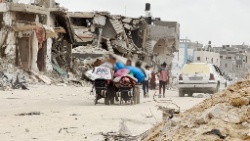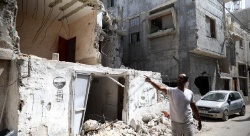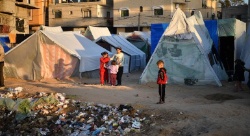Cablegate: Israel: 2008 Country Reports On Terrorism
O 221607Z DEC 08
FM AMEMBASSY TEL AVIV
TO SECSTATE WASHDC IMMEDIATE 9718
INFO NCTC WASHINGTON DC PRIORITY
UNCLAS TEL AVIV 002865
STATE FOR S/CT (R.SHORE)
NCTC
E.O. 12958: N/A
TAGS: PTER ASEC IS
SUBJECT: ISRAEL: 2008 COUNTRY REPORTS ON TERRORISM
REF: A. STATE 124815
B. STATE 120019
1. The following is Post's submission for the 2008 Country
Report on Terrorism for Israel. Embassy Tel Aviv's point of
contact for this report is: Jason Grubb, Political-Military
Officer, Tel: 972-3-519-7460; e-mail: GrubbJB@State.gov.
2. Begin Text:
Israel
Twenty-four Israeli civilians were killed in 10 separate
terrorist attacks during the year, up from six attacks in
2007. Israel continued to suffer from terrorist threats
emanating from the West Bank and Gaza. Israeli security
sources continued to express concern that Al-Qa'ida (AQ) and
other external Sunni extremists might have greater influence
over or even infiltrate the West Bank and Gaza. Claims of an
actual AQ presence in the West Bank and Gaza have not been
substantiated. Rocket and even more accurate mortar fire
emanating from the Gaza Strip was the Palestinian terrorist
organizations' preferred form of attack, while incidents of
Palestinian suicide bombing terrorism continued to decline
relative to previous years.
Israel responded to the terrorist threat as it has in recent
years, with targeted operations directed at terrorist
leaders, terror infrastructure, and active terror activities
such as rocket launching groups. Israel Defense Forces (IDF)
and Israel Security Services (ISA) incursions into the West
Bank continued to conduct roundups and other military
operations designed to increase pressure on Palestinian
terrorist organizations and their supporters. The Israeli
security services also imposed strict and widespread closures
and curfews in Palestinian areas. Due to budgetary
constraints, construction on an extensive security barrier in
the West Bank and Jerusalem was sporadic in 2008. Israeli
officials believe the fence has played an important role in
making terrorist attacks more difficult to undertake. In some
areas in the West Bank, such as Jenin, Israeli authorities
eased curfews and reduced incursions to mitigate effects on
the local population while maintaining a strong
counterterrorism presence.
Terrorist attacks that resulted in injuries and the Israeli
responses included:
-- On February 4, a Palestinian suicide bomber struck a
shopping mall in the southern town of Dimona, killing one
person and injuring nine others. Israeli police killed a
second attacker before he was able to detonate his bomb belt.
Two terrorist groups, the al-Aqsa Martyrs' Brigade (AAMB) and
the Popular Front for the Liberation of Palestine (PFLP),
claimed joint responsibility for the attack.
-- On March 6, a Palestinian resident of East Jerusalem shot
and killed eight students and wounded 11 others at the
prominent Mercaz Harav Kook Yeshiva (Jewish religious school)
in West Jerusalem. An off-duty soldier entered the yeshiva
and killed the assailant.
-- On April 25, a terrorist operating on behalf of Hamas and
the Palestinian Islamic Jihad (PIJ) infiltrated Israel from
the West Bank and shot to death two civilian security guards
at an industrial park near the village of Qalansuwa.
-- On July 2, a Palestinian resident of East Jerusalem killed
three people and wounded at least 18 others with a bulldozer
in West Jerusalem before being shot and killed by an off-duty
soldier. The government defined the incident as a terrorist
attack, but police were unable to determine a clear motive.
Separately, on July 22, a second Palestinian resident of East
Jerusalem wounded at least 16 people with a bulldozer on a
busy West Jerusalem street before being killed by police. The
attack was widely viewed as a copycat of the July 2 attack.
-- On September 25, prominent Hebrew University professor and
critic of Jewish settlements in the West Bank Ze'ev Sternhall
was wounded when a pipe bomb, allegedly planted by radical
members of the settlement movement, exploded as he opened the
door of his home in West Jerusalem. After the attack, police
found flyers near Sternhall's home calling for the
establishment of a new state in the West Bank based on Jewish
religious law. The flyers, signed by a Jewish extremist group
called the Army of the State Liberators, also offered USD
314,000 (1.1 million NIS) to anyone who killed a member of
the NGO Peace Now. The ISA continues to investigate the
attack.
-- On November 26-28, terrorists killed four Israeli citizens
at the Chabad House in Mumbai, India. According to press
reports, Indian commandoes killed two terrorists during the
assault on the house.
-- During the year, rocket, mortar, and sniper fire from the
Gaza Strip killed six Israeli civilians and one Ecuadoran
kibbutz volunteer.
Throughout the year, Israel's security services were able to
keep terrorist planners and operators off balance, reporting
multiple foiled attempts. On January 16, IDF, Civil
Administration and police forces intercepted a truck
containing 800 kg of potassium/nitrate at the Eliyahu border
crossing south of Qalqiliya, West Bank. Potassium nitrate is
a banned substance in Gaza and the West Bank due to its use
in the manufacturing of explosive devices and Qassam rockets.
On November 4, IDF and security forces discovered a tunnel
situated 250 meters from the Gaza security fence that they
believed would be used for the abduction of IDF soldiers.
Israeli forces killed several militants during an ensuring
firefight. On November 12, IDF forces killed four armed
militants in Gaza attempting to place an explosive device
near the Gaza security fence. On November 28, IDF forces
identified another attempt by terrorists to lay an explosive
device at the Gaza security fence near Khan Yunis. In an
ensuing firefight, IDF forces killed one terrorist and
wounded four others.
The smuggling of commodities, arms, explosives, and funds in
support of terrorist groups such as Hamas through tunnels
along the Philadelphi Route between the Gaza Strip and Egypt
continued to prove problematic. On January 23, Hamas
terrorists blew up several sections of the border fence
separating the Gaza Strip from the Egyptian town of Rafah.
According to the Israeli Ministry of Foreign Affairs, Hamas
utilized this opportunity to smuggle explosives, anti-tank
and anti-aircraft weapons into the Gaza Strip. Israel
contended that Egypt did not do enough during the past year
to stop the smuggling of arms and explosives from the Sinai
into Gaza through over 900 tunnels.
Despite the fact that Palestinian terrorists were relatively
unsuccessful in carrying out suicide bombings and other
attacks within Israel, they conducted mortar attacks against
the Israeli-manned crossings between Gaza and Israel, and
Qassam rocket launches from Gaza that terrorized Israeli
communities abutting Gaza. Palestinian terrorists routinely
fired rockets and mortars at Israeli civilians from the Gaza
Strip despite an Egyptian-negotiated truce or cease fire
("tahdiyah") between Israel and Hamas that began on June 19.
According to the Israeli Ministry of Foreign Affairs (MFA),
Palestinian terrorist groups fired 1,212 rockets and
approximately 1,290 mortars into Israel between January 1 and
October 31, up from 896 rockets and 749 mortars in 2007.
Rocket and mortar attacks began to escalate toward the end of
the year; the MFA estimated that Palestinian terrorist groups
fired 213 rockets and 126 mortars at Israel from November 4
to December 18. On December 17, the press reported that
terrorist groups in Gaza fired 25 Qassam rockets at Israel.
On December 18, Hamas leadership announced the end of the
ceasefire, although it is unclear at this time whether
full-scale hostilities will resume.
Targeted Israeli towns included Sderot and Ashkelon, as well
as a number of nearby agricultural collectives (kibbutzim)
and IDF bases. Palestinian terrorist groups increasingly used
122 mm Grad missiles, which landed in or near Ashkelon. While
there have been no fatalities resulting from rocket and
mortar attacks since the June 19 ceasefire, these attacks
resulted in numerous cases of shock and property damage, and
disrupted daily life.
The Israeli security services assessed that the use of
rockets and mortars reflected recognition by the groups
launching them that their best chances for success are
through asymmetrical warfare, especially in light of the
stringent physical security measures that limit the movement
of potential suicide bombers into Green Line Israel. The
reliance on rockets also reflected technological advancements
that allowed groups to manufacture the rockets cheaply,
stockpile them, and launch them greater distances. As the
rockets' ranges continue to increase, Israeli authorities in
the port city of Ashdod initiated emergency response training
in anticipation of eventual rocket attacks in their city.
Mortars were used mainly against Israeli targets within or on
the edge of the Gaza Strip, to include crossings, which had
the effect of closing the crossings to the detriment of
Gaza's residents.
On February 29 to March 1, the IDF conducted Operation Warm
Winter against terror targets in Gaza - the last large scale
IDF action of this year. Following the November 4 tunnel
discovery along the Gaza security fence, Israel undertook
small-scale military operations and airstrikes against
suspected launch teams and sites in Gaza. The Israeli Air
Force increasingly launched airstrikes against launch teams
in November and December following the escalation in rocket
and mortar attacks. The Israeli government maintained the
option to again authorize targeted operations against
terrorist leaders and operatives.
Israel's security establishment remained concerned about the
terrorist threat posed to Israel in the north by Hizballah
and its Iranian and Syrian backers. Israeli security
officials said Hizballah continued to provide support to
select Palestinian groups to augment their capacity to
conduct attacks against Israel. Israeli politicians and
security officials pointed to Hizballah's efforts to rebuild
and rearm after the 2006 Second Lebanon War as evidence that
Hizballah remained a threat to Israel. Throughout the rest of
the year, Israeli officials claimed publicly that Hizballah
had completely replenished its ranks, possessed even more
short and medium-range rockets than it had before the 2006
war, had moved arms back to southern Lebanon, and was
providing training to Hamas operatives from Gaza. However,
Israel's northern border remained comparatively quiet during
the course of the year. The IDF continued a strong exercise
schedule and military presence in the Golan Heights.
The finance of terrorist entities such as Hamas and Hizballah
that consider Israel a target is accomplished mostly through
state-sponsors of terrorism such as Iran, and through various
fundraising techniques drawing on charity networks in Europe,
the United States, the Middle East, and to a lesser extent,
elsewhere. The funds channeled to these organizations
frequently passed through major international financial
capitals, such as Dubai, Bahrain, Hong Kong, Zurich, London,
or New York. Unlawful funding bound for terrorists that may
pass through Israel's financial sector, however, is well
monitored and often blocked. Israel has adopted strong
measures to prevent the financing of terrorism through its
financial sector or through the smuggling of financial
instruments. Regulation and enforcement of its domestic
financial industry is equivalent in scope and effect to other
highly industrialized and developed nations. Israel's
Counter-Terrorism Finance regime is administered as part of
its Anti-Money Laundering program (AML/CFT).
The Israeli National Police (INP) with the advice of the
security services is charged with enforcement of
counter-terrorism finance laws. Regulation of and
intelligence on financial crimes is coordinated by the Israel
Money Laundering and Terror Financing Prohibition Authority
(IMPA) in coordination with the National Security Council.
Israel reports its financial crime statistics to include,
inter alia, the financing of terrorism. For 2008, the INP
reported no indication of an overall increase in financial
crime relative to previous years. In 2007, IMPA reported 56
arrests and five prosecutions relating to money laundering
and/or terrorist financing. In 2008, IMPA received
approximately 17,152 suspicious transaction reports. During
this period IMPA disseminated 529 intelligence reports to law
enforcement agencies and to foreign Financial Intelligence
Units (FIUs) in response to requests, and on its own
initiative. In 2007, the INP seized approximately USD nine
million in suspected criminal assets. For 2008, the IMPA
reports that approximately USD two million (about NIS7.7
million) was frozen or forfeited in AML/CTF-related actions.
On the law enforcement front, the ISA and INP continued to
cooperate with U.S. law enforcement agencies on cases'
involving U.S. citizens killed in terrorist attacks. On
October 29, the Israeli parliament (Knesset) voted to
continue work on a biometrics bill by sending it to the
Constitution, Law, and Justice Committee for further work.
The bill proposes that Israel switch to "smart"
identification methods such as fingerprints and digital
photographs on identification cards and passports. The GOI
released convicted Lebanese terrorist Samir Kuntar and four
Hizballah militants on July 16 in exchange for the remains of
two Israeli soldiers whose capture by Hizballah sparked the
2006 Second Lebanon War.
Press reports also highlighted numerous attempts to kidnap
Israeli citizens or high-value targets of interest, including
foreign diplomats and journalists. The Israeli
Counter-Terrorism Bureau issued a warning in October in
advance of the Jewish holiday season that terrorist groups
may attempt to kidnap Israeli tourists in the Sinai.
Terrorists held hostage and later killed four Israeli
citizens at the Chabad House as part of the November attacks
on Mumbai, India.
End text.
********************************************* ********************
Visit Embassy Tel Aviv's Classified Website:
http://www.state.sgov.gov/p/nea/telaviv
********************************************* ********************
CUNNINGHAM


 Being LBGTI in Asia: UNDP And ILGA World Launch The International Pride Awards, Recognising LGBTIQ+ Equality Champions
Being LBGTI in Asia: UNDP And ILGA World Launch The International Pride Awards, Recognising LGBTIQ+ Equality Champions UN News: UN Teams Dispatch Aid As Deadly Flash Floods Hit Northern Afghanistan
UN News: UN Teams Dispatch Aid As Deadly Flash Floods Hit Northern Afghanistan Save The Children: It’s Not Safe And It’s Not Clean, But People Believe They Are Leaving Something Worse Behind
Save The Children: It’s Not Safe And It’s Not Clean, But People Believe They Are Leaving Something Worse Behind APEC: APEC Commits To Empowering People With Disabilities
APEC: APEC Commits To Empowering People With Disabilities UN News: Israeli Forces Bringing War To The West Bank, Warns UN Rights Office
UN News: Israeli Forces Bringing War To The West Bank, Warns UN Rights Office UN News: 10,000 People Feared Buried Under The Rubble In Gaza
UN News: 10,000 People Feared Buried Under The Rubble In Gaza